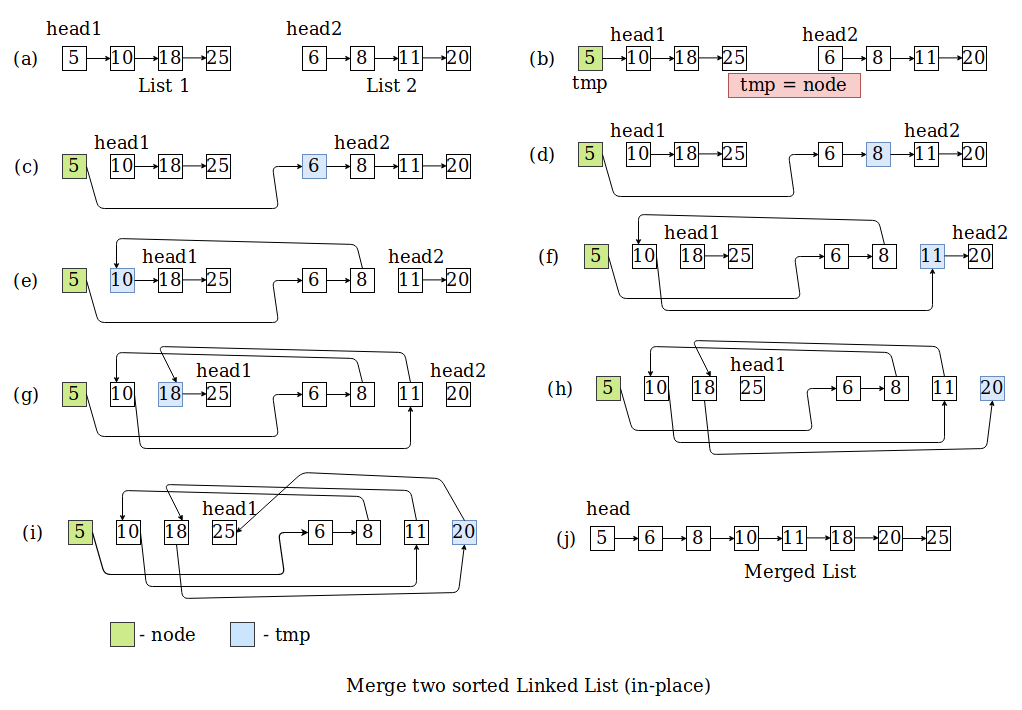Merge two sorted Linked List (in-place) | C++ Implementation
Publish date: 2018-02-06
Tags:
<a href="https://programmercave.com/tags/Cpp/">Cpp</a>, <a href="https://programmercave.com/tags/Algorithm/">Algorithm</a>, <a href="https://programmercave.com/tags/Linked-List/">Linked-List</a>, <a href="https://programmercave.com/tags/Data-Structure/">Data-Structure</a>
Given two sorted Linked List, we have to merge them without using another linked list.
List 1 : { 5, 10, 18, 25 }
List 2 : { 6, 8, 11, 20 }
Merged List : { 5, 6, 8, 10, 11, 18, 20, 25 }

From the above fig. we can see that merging two linked list is same as merging two sorted array in mergesort.
Related: Merge Sort
node stores the smallest element in both linked list and it will become the head of the merged linked list later.
head1 and head2 are the nodes whose data item is to be compared and node with smallest data item is added after tmp. tmp is always the last node in merged list.
Here is mergeSortedList functions.
void mergeSortedList(LinkedList<T>& ll2)
{
if(ll2.head == nullptr)
return;
if(head == nullptr)
{
head = ll2.head;
ll2.head = nullptr;
return;
}
Node *head1 = head;
Node *head2 = ll2.head;
Node *node;
if(head1->data <= head2->data)
{
node = head1;
advance(head1);
}
else if(head2->data <= head1->data)
{
node = head2;
advance(head2);
}
Node *tmp = nullptr;
tmp = node;
while(head1 != nullptr && head2 != nullptr)
{
if(head1->data <= head2->data)
{
tmp->next = head1;
advance(head1);
}
else
{
tmp->next = head2;
advance(head2);
}
advance(tmp);
}
//if there are extra nodes in either list
if(head1 != nullptr)
tmp->next = head1;
if(head2 != nullptr)
tmp->next = head2;
head = node;
ll2.head = nullptr;
}
#include <iostream>
#include <utility>
#include <cassert>
template<class T>
class LinkedList
{
struct Node
{
T data;
Node * next = nullptr;
Node() : data(), next(nullptr) {}
Node(T value) : data(std::move(value)), next(nullptr) {}
};
Node *head;
public:
LinkedList() : head(nullptr) {}
LinkedList(const LinkedList& ll) = delete; //copy constructor
LinkedList& operator=(const LinkedList& ll) = delete; //copy assignment
~LinkedList()
{
Node *tmp = nullptr;
while(head)
{
tmp = head;
head = head->next;
delete tmp;
}
head = nullptr;
}
void insert(T);
void mergeSortedList(LinkedList<T>&);
void printList() const;
private:
static void advance(Node*& node)
{
assert(node != nullptr);
node = node->next;
}
Node* getLastNode(Node*& node)
{
while(node->next != nullptr)
node = node->next;
return node;
}
};
template <class T>
void LinkedList<T>::insert(T value)
{
Node *node = new Node(std::move(value));
Node *tmp = head;
if(tmp == nullptr)
{
head = node;
}
else
{
tmp = getLastNode(tmp);
tmp->next = node;
}
}
template <class T>
void LinkedList<T>::mergeSortedList(LinkedList<T>& ll2)
{
if(ll2.head == nullptr)
return;
if(head == nullptr)
{
head = ll2.head;
ll2.head = nullptr;
return;
}
Node *head1 = head;
Node *head2 = ll2.head;
Node *node;
if(head1->data <= head2->data)
{
node = head1;
advance(head1);
}
else if(head2->data <= head1->data)
{
node = head2;
advance(head2);
}
Node *tmp = nullptr;
tmp = node;
while(head1 != nullptr && head2 != nullptr)
{
if(head1->data <= head2->data)
{
tmp->next = head1;
advance(head1);
}
else
{
tmp->next = head2;
advance(head2);
}
advance(tmp);
}
//if there are extra nodes in either list
if(head1 != nullptr)
tmp->next = head1;
if(head2 != nullptr)
tmp->next = head2;
head = node;
ll2.head = nullptr;
}
template <class T>
void LinkedList<T>::printList() const
{
if(head == nullptr)
{
std::cout << "Empty List \n";
return;
}
Node *node = head;
while(node != nullptr)
{
std::cout << node->data << " ";
advance(node);
}
std::cout << "\n";
}
int main()
{
LinkedList<int> ll1;
ll1.insert(5);
ll1.insert(10);
ll1.insert(18);
ll1.insert(25);
std::cout << "List 1 : ";
ll1.printList();
LinkedList<int> ll2;
ll2.insert(6);
ll2.insert(8);
ll2.insert(11);
ll2.insert(20);
ll2.insert(23);
ll2.insert(28);
ll2.insert(40);
std::cout << "List 2 : ";
ll2.printList();
ll1.mergeSortedList(ll2);
std::cout << "Merged List : ";
ll1.printList();
}
View this code on Github
Reference: Introduction to Algorithms The Algorithm Design Manual Data Structures and Algorithms Made Easy
Tags:
<a href="https://programmercave.com/tags/Cpp/">Cpp</a>, <a href="https://programmercave.com/tags/Algorithm/">Algorithm</a>, <a href="https://programmercave.com/tags/Linked-List/">Linked-List</a>, <a href="https://programmercave.com/tags/Data-Structure/">Data-Structure</a>